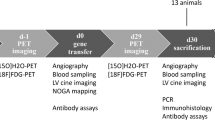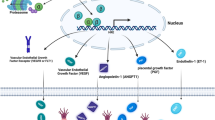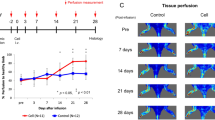Abstract
Gene therapy approaches delivering fibroblast growth factor-2 (FGF-2) have shown promise as a potential treatment for increasing blood flow to ischemic limbs. Currently, effective noninvasive techniques to deliver plasmids encoding genes of therapeutic interest, such as FGF-2, are limited. We sought to determine if intradermal injection of plasmid DNA encoding FGF-2 (pFGF) followed by noninvasive cutaneous electroporation (pFGFE+) could increase blood flow and angiogenesis in a rat model of hindlimb ischemia. pFGFE+ or control treatments were administered on postoperative day 0. Compared to injection of pFGF alone (pFGFE−), delivery of pFGFE+ significantly increased FGF-2 expression for 10 days. Further, the increase in FGF-2 expression with pFGFE+ was sufficient to significantly increase ischemic limb blood flow, measured by laser Doppler perfusion imaging, beginning on postoperative day 3. Ischemic limb blood flow in the pFGFE+ treatment group remained significantly higher than all control groups through the end point of the study, postoperative day 14. Immunohistochemical staining of gastrocnemius cross sections determined there was a twofold increase in capillary density in the pFGFE+ treatment group. Our results suggest that pFGFE+ is a potential noninvasive, nonviral therapeutic approach to increase perfusion and angiogenesis for the treatment of limb ischemia.
This is a preview of subscription content, access via your institution
Access options
Subscribe to this journal
Receive 12 print issues and online access
$259.00 per year
only $21.58 per issue
Buy this article
- Purchase on Springer Link
- Instant access to full article PDF
Prices may be subject to local taxes which are calculated during checkout



Similar content being viewed by others
References
Gardner AW, Poehlman ET . Exercise rehabilitation programs for the treatment of claudication pain. A meta-analysis. JAMA 1995; 274: 975–980.
Robeer G, Brandsma J, van den Heuvel S, Smit B, Oostendorp R, Wittens C . Exercise therapy for intermittent claudication: a review of the quality of randomized clinical trials and evaluation of predictive factors. Eur J Vasc Endovasc 1998; 15: 36–43.
Dormandy J, Rutherford R . Management of peripheral arterial disease (PAD). J Vasc Surg 2000; 31: s3.
Rissanen TT, Vajanto I, Yla-Herttuala S . Gene therapy for therapeutic angiogenesis in critically ischaemic lower limb—on the way to the clinic. Eur J Clin Invest 2001; 31: 651–666.
Norgren L, Hiatt WR, Dormandy JA, Nehler MR, Harris KA, Fowkes FGR . Inter-Society Consensus for the Management of Peripheral Arterial Disease (TASC II). Eur J Vasc Endovasc Surg 2007; 33: S1–S75.
Aviles RJ, Annex BH, Lederman RJ . Testing clinical therapeutic angiogenesis using basic fibroblast growth factor (FGF-2). Br J Pharmacol 2003; 140: 637–646.
Carmeliet P, Jain RK . Angiogenesis in cancer and other diseases. Nature 2000; 407: 249–257.
Carmeliet P . Angiogenesis in health and disease. Nat Med 2003; 9: 653–660.
Bobek V, Taltynov O, Pinterova D, Kolostova K . Gene therapy of the ischemic lower limb—therapeutic angiogenesis. Vasc Pharmacol 2006; 44: 395–405.
Presta M, Dell’Era P, Mitola S, Moroni E, Ronca R, Rusnati M . Fibroblast growth factor/fibroblast growth factor receptor system in angiogenesis. Cytokine Growth Factor Rev 2005; 16: 159–178.
Heller R, Cruz Y, Heller LC, Gilbert RA, Jaroszeski MJ . Electrically mediated delivery of plasmid DNA to the skin, using a multielectrode array. Hum Gene Ther 2010; 21: 1–6.
Fujii T, Yonemitsu Y, Onimaru M, Inoue M, Hasegawa M, Kuwano H et al. VEGF function for upregulation of endogenous PlGF expression during FGF-2-mediated therapeutic angiogenesis. Atherosclerosis 2008; 200: 51–57.
Lee J-S, Kim J-M, Kim KL, Jang H-S, Shin I-S, Jeon E-S et al. Combined administration of naked DNA vectors encoding VEGF and bFGF enhances tissue perfusion and arteriogenesis in ischemic hindlimb. Biochem Biophys Res Commun 2007; 360: 752–758.
Nishikage S, Koyama H, Miyata T, Ishii S, Hamada H, Shigematsu H . In vivo electroporation enhances plasmid-based gene transfer of basic fibroblast growth factor for the treatment of ischemic limb. J Surg Res 2004; 120: 37–46.
Nagasaka M, Kohzuki M, Fujii T, Kanno S, Kawamura T, Onodera H et al. Effect of low-voltage electrical stimulation on angiogenic growth factors in ischaemic rat skeletal muscle. Clin Exp Pharmacol Physiol 2006; 33: 623–627.
Kanno S, Oda N, Abe M, Saito S, Hori K, Handa Y et al. Establishment of a simple and practical procedure applicable to therapeutic angiogenesis. Circulation 1999; 99: 2682–2687.
Scholz D, Ziegelhoeffer T, Helisch A, Wagner S, Friedrich C, Podzuweit T et al. Contribution of arteriogenesis and angiogenesis to postocclusive hindlimb perfusion in mice. J Mol Cell Cardiol 2002; 34: 775–787.
Vogel J . Nonviral skin gene therapy. Hum Gene Ther 2000; 11: 2253–2259.
Heller R, Schultz J, Lucas ML, Jaroszeski MJ, Heller LC, Gilbert RA et al. Intradermal delivery of interleukin-12 plasmid DNA by in vivo electroporation. DNA Cell Biol 2001; 20: 21–26.
Glasspool-Malone J, Somiari S, Drabick J, Malone R . Efficient nonviral cutaneous transfection. Mol Ther 2000; 2: 140–146.
Dujardin N, Van Der Smissen P, Preat V . Topical gene transfer into rat skin using electroporation. Pharm Res 2001; 18: 61–66.
Drabick JJ, Glasspool-Malone J, Somiari S, King A, Malone RW . Cutaneous transfection and immune responses to intradermal nucleic acid vaccination are significantly enhanced by in vivo electropermeabilization. Mol Ther 2001; 3: 249–255.
Medi BM, Hoselton S, Marepalli R, Singh J . Skin targeted DNA vaccine delivery using electroporation in rabbits: I: efficacy. Int J Pharm 2005; 294: 53–63.
Babiuk S, Baca-Estrada ME, Foldvari M, Storms M, Rabussay D, Widera G et al. Electroporation improves the efficacy of DNA vaccines in large animals. Vaccine 2002; 20: 3399–3408.
Hooper J, Golden J, Ferro A, King A . Smallpox DNA vaccine delivered by novel skin electroporation device protects mice against intranasal poxvirus challenge. Vaccine 2007; 25: 1814–1823.
Hirao LA, Wu L, Khan AS, Satishchandran A, Draghia-Akli R, Weiner DB . Intradermal/subcutaneous immunization by electroporation improves plasmid vaccine delivery and potency in pigs and rhesus macaques. Vaccine 2008; 26: 440–448.
Marti G, Ferguson M, Wang J, Byrnes C, Dieb R, Qaiser R et al. Electroporative transfection with KGF-1 DNA improves wound healing in a diabetic mouse model. Gene Therapy 2004; 11: 1780–1785.
Liu L, Marti GP, Wei X, Zhang X, Zhang H, Liu YV et al. Age-dependent impairment of HIF-1alpha expression in diabetic mice: correction with electroporation-facilitated gene therapy increases wound healing, angiogenesis, and circulating angiogenic cells. J Cell Physiol 2008; 217: 319–327.
Lee P-Y, Chesnoy S, Huang L . Electroporatic delivery of TGF-B1 gene works synergistically with electric therapy to enhance diabetic wound healing in db/db mice. J Investig Dermatol 2004; 123: 791–798.
Lin MP, Marti GP, Dieb R, Wang J, Ferguson M, Qaiser R et al. Delivery of plasmid DNA expression vector for keratinocyte growth factor-1 using electroporation to improve cutaneous wound healing in a septic rat model. Wound Repair Regen 2006; 14: 618–624.
Ylä-Herttuala S, Alitalo K . Gene transfer as a tool to induce therapeutic vascular growth. Nat Med 2003; 9: 694–701.
Muruve D, Barnes M, Stillman I, Libermann T . Adenoviral gene therapy leads to rapid induction of multiple chemokines and acute neutrophil-dependent hepatic injury in vivo. Hum Gene Ther 1999; 10: 965–976.
Cooper Jr LT, Hiatt WR, Creager MA, Regensteiner JG, Casscells W, Isner JM et al. Proteinuria in a placebo-controlled study of basic fibroblast growth factor for intermittent claudication. Vasc Med 2001; 6: 235–239.
Wafai R, Tudor EM, Angus JA, Wright CE . Vascular effects of FGF-2 and VEGF-B in rabbits with bilateral hind limb ischemia. J Vasc Res 2008; 46: 45–54.
Cao R, Brakenhielm E, Pawliuk R, Wariaro D, Post M, Wahlberg E et al. Angiogenic synergism, vascular stability and improvement of hind-limb ischemia by a combination of PDGF-BB and FGF-2. Nat Med 2003; 9: 604–613.
Masaki I, Yonemitsu Y, Yamashita A, Sata S, Tanii M, Komori K et al. Angiogenic gene therapy for experimental critical limb ischemia: acceleration of limb loss by overexpression of vascular endothelial growth factor 165 but not of fibroblast growth factor-2. Circ Res 2002; 90: 966–973.
Lazarous DF, Unger EF, Epstein SE, Stine A, Arevalo JL, Chew EY et al. Basic fibroblast growth factor in patients with intermittent claudication: results of a phase I trial. J Am Coll Cardiol 2000; 36: 1239–1244.
Lederman R, Mendelsohn F, Anderson R, Saucedo J, Tenaglia A, Hermiller J et al. Therapeutic angiogenesis with recombinant fibroblast growth factor-2 for intermittent claudication (the TRAFFIC study): a randomised trial. Lancet 2002; 359: 2053–2058.
Marui A, Tabata Y, Kojima S, Yamamoto M, Tambara K, Nishina T et al. A novel approach to therapeutic angiogenesis for patients with critical limb ischemia by sustained release of basic fibroblast growth factor using biodegradable gelatin hydrogel: an initial report of the phase I-IIa study. Circ J 2007; 71: 1181–1186.
Bush MA, Samara E, Whitehouse MJ, Yoshizawa C, Novicki DL, Pike M et al. Pharmacokinetics and pharmacodynamics of recombinant FGF-2 in a phase I trial in coronary artery disease. J Clin Pharmacol 2001; 41: 378–385.
Kandel J, Bossy-Wetzel E, Radvanyi F, Klagsbrun M, Folkman J, Hanahan D . Neovascularization is associated with a switch to the export of bFGF in the multistep development of fibrosarcoma. Cell 1991; 66: 1095–1104.
Korpisalo P, Rissanen TT, Bengtsson T, Liimatainen T, Laidinen S, Karvinen H et al. Therapeutic angiogenesis with placental growth factor improves exercise tolerance of ischaemic rabbit hindlimbs. Cardiovasc Res 2008; 80: 263–270.
Luttun A, Tjwa M, Moons L, Wu Y, Angelillo-Scherrer A, Liao F et al. Revascularization of ischemic tissues by PlGF treatment, and inhibition of tumor angiogenesis, arthritis and atherosclerosis by anti-Flt1. Nat Med 2002; 8: 831–840.
Taniyama Y, Morishita R, Hiraoka K, Aoki M, Nakagami H, Yamasaki K et al. Therapeutic angiogenesis induced by human hepatocyte growth factor gene in rat diabetic hind limb ischemia model: molecular mechanisms of delayed angiogenesis in diabetes. Circulation 2001; 104: 2344–2350.
Onimaru M, Yonemitsu Y, Tanii M, Nakagawa K, Masaki I, Okano S et al. Fibroblast growth factor-2 gene transfer can stimulate hepatocyte growth factor expression irrespective of hypoxia-mediated downregulation in ischemic limbs. Circ Res 2002; 91: 923–930.
Acknowledgements
We thank William Marshall, MD (University of South Florida, College of Medicine) for his insight into vascular biology and valuable review of the article and Mark Jaroszeski (University of South Florida, College of Engineering) for construction of the MultiElectrode Array. This work was supported by the Defense Threat Reduction Agency and the Florida Center of Excellence for Biomolecular Identification and Targeted Therapeutics.
Author information
Authors and Affiliations
Corresponding author
Ethics declarations
Competing interests
Richard Heller is an inventor on patents used in this work. These patents have been licensed to RMR Technologies, LLC and Inovio Biomedical Corporation. Richard Heller has ownership interest in RMR Technologies and owns stock and stock options of Inovio Biomedical Corporation.
Rights and permissions
About this article
Cite this article
Ferraro, B., Cruz, Y., Baldwin, M. et al. Increased perfusion and angiogenesis in a hindlimb ischemia model with plasmid FGF-2 delivered by noninvasive electroporation. Gene Ther 17, 763–769 (2010). https://doi.org/10.1038/gt.2010.43
Received:
Revised:
Accepted:
Published:
Issue Date:
DOI: https://doi.org/10.1038/gt.2010.43
Keywords
This article is cited by
-
Rescue of murine hind limb ischemia via angiogenesis and lymphangiogenesis promoted by cellular communication network factor 2
Scientific Reports (2023)
-
Application of temporal correlation algorithm to interpret laser Doppler perfusion imaging
Lasers in Medical Science (2019)
-
Skin Electroporation of a Plasmid Encoding hCAP-18/LL-37 Host Defense Peptide Promotes Wound Healing
Molecular Therapy (2014)
-
A bioreducible polypeptide for efficient gene transfection both in vitro and in vivo
Chinese Journal of Polymer Science (2013)



